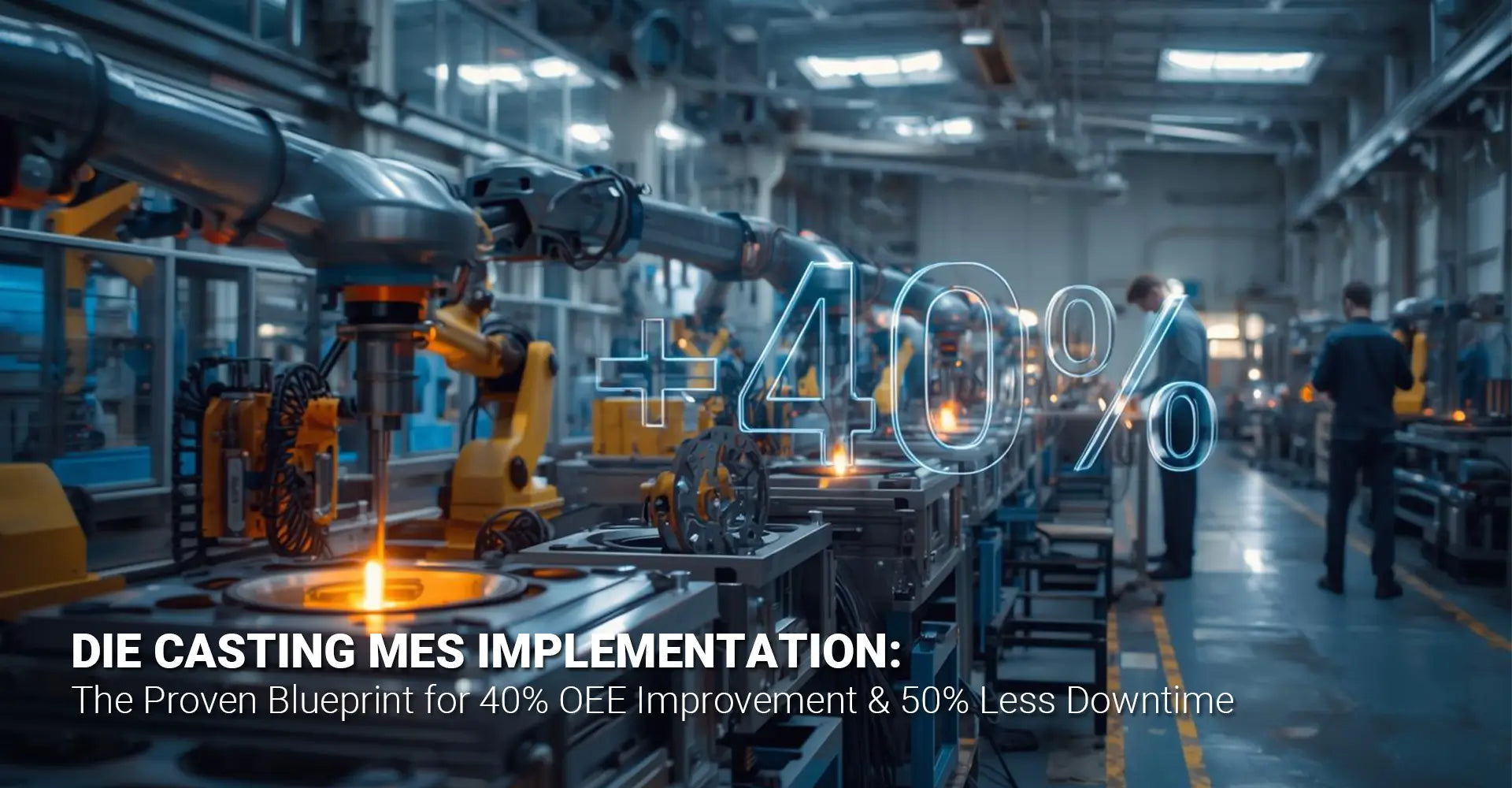How Can Die Casting MES Systems Deliver 40% Better OEE and Cut Downtime in Half?

How Can Die Casting MES Systems Deliver 40% Better OEE and Cut Downtime in Half?

Opening the Door to Measurable Production Gains
Die casting facilities lose thousands of dollars daily to hidden inefficiencies. Moreover, most production managers don't realize how much potential their operations actually have. In fact, recent industry data shows that implementing a Manufacturing Execution System (MES) can boost Overall Equipment Effectiveness (OEE) by 40% while cutting unplanned downtime by 50%. This comprehensive guide reveals exactly how die casting shops achieve these dramatic improvements through smart MES implementation.
Quick Wins: What MES Delivers to Your Bottom Line
| Key Benefit | Average Improvement | Timeframe |
|---|---|---|
| OEE Increase | 35-40% | 6-12 months |
| Downtime Reduction | 45-50% | 3-6 months |
| Lead Time Decrease | 25-30% | 6 months |
| Material Waste Savings | 3-5% | 3-4 months |
| ROI Achievement | Full payback | 12-18 months |
Why these numbers matter: Every percentage point of OEE improvement adds real production capacity without buying new equipment. Similarly, cutting downtime by half means you can fulfill more orders with your existing machines. These aren't theoretical benefits but proven results from facilities just like yours.
Understanding the Path Forward
Understanding these numbers is just the beginning. Therefore, let's explore exactly how MES systems create these measurable improvements in your die casting operation. Furthermore, you'll discover the specific strategies that separate successful implementations from failed attempts. By the end of this guide, you'll have a clear blueprint for achieving similar results in your own facility.
Table of Contents
- The Hidden Inefficiencies: What Your Production Reports Aren't Showing You?
- How Does Real-Time Data Expose Your True Production Bottlenecks?
- What Makes OEE Tracking the Game-Changer for Die Casting Operations?
- How Can You Eliminate Downtime Through Predictive Maintenance?
- Conclusion
The Hidden Inefficiencies: What Your Production Reports Aren't Showing You?
Traditional production tracking methods miss critical information every single day. Additionally, spreadsheet-based reporting often arrives too late to prevent costly mistakes. Manual data collection creates gaps where problems hide and grow unnoticed. Consequently, many facilities operate with a false sense of confidence about their actual performance.
The Critical Data Gaps Costing You Money
Five Critical Data Gaps in Traditional Tracking:
- Machine idle time between production runs goes unmeasured and unaccounted
- Setup duration varies wildly without documented standards or benchmarks
- Minor stops under 5 minutes never get recorded in daily reports
- Quality issues don't connect to specific process parameters or operators
- Operator efficiency differences remain invisible across shifts and teams
These gaps aren't just academic concerns. Rather, they represent real money leaving your facility every single day. Without accurate data, you cannot make informed decisions about improvements or investments.
Uncovering Your True Production Capacity
Most die casting operations believe they understand their production capacity thoroughly. However, detailed MES analysis typically reveals 15-25% hidden capacity that manual tracking simply cannot capture. For instance, micro-stoppages lasting 2-3 minutes each add up to hours of lost production weekly. Furthermore, without timestamp data on every cycle, you cannot identify which shifts, operators, or machines perform best.
Consequently, improvement efforts target symptoms rather than root causes. A supervisor might blame operators for low output when the real problem is excessive die changeover time. Or management might purchase new equipment when better utilization of existing machines would solve capacity constraints.
MES systems automatically capture every production event with precise timing and context. This granular data shows exactly where time disappears throughout your operation. You'll see which machines spend 30 minutes warming up each morning or which products require twice as long for setup as estimated. Moreover, the system tracks these patterns over weeks and months, revealing trends that daily reports obscure completely.
The Die casting MES system efficiency gains start immediately once you see the complete picture. Teams can address the biggest time-wasters first, generating quick wins that build momentum for broader improvements.
How Does Real-Time Data Expose Your True Production Bottlenecks?
Identifying bottlenecks after production runs finish provides little value for immediate action. Instead, real-time production monitoring lets you respond immediately when problems occur. Therefore, MES systems shift operations from reactive firefighting to proactive management that prevents small issues from becoming big problems.
Instant Visibility Drives Immediate Action
Real-Time Monitoring Delivers Instant Insights:
- Live machine status displays show which cells need attention right now
- Automatic alerts notify supervisors within 30 seconds of any stoppages
- Cycle time comparisons highlight underperforming equipment immediately
- Work-in-progress tracking prevents upstream overproduction and material waste
- Quality data links directly to process parameters for fast troubleshooting
These capabilities transform how production teams work daily. Instead of discovering problems hours after they occur, supervisors receive immediate notifications with actionable information. The system doesn't just say "Machine 7 stopped" but rather "Machine 7 stopped – die temperature alarm – 2:47 PM."

Turning Data Into Faster Response Times
Consider a typical scenario in die casting facilities without MES. A machine stops unexpectedly, but the supervisor doesn't discover the issue until their next floor walk 20 minutes later. Meanwhile, that machine sits idle while operators wait for direction or move to other tasks. The delay costs 20 minutes of production plus additional time restarting and returning to normal cycle times.
In contrast, MES systems send immediate notifications when machines stop running. Supervisors receive alerts on mobile devices with the exact machine location and reason code. Additionally, the system tracks how long each stoppage lasts and who responds. This accountability alone reduces average response time by 60-70% in most facilities.
Beyond stoppages, real-time data reveals patterns invisible in daily reports. You might discover that Machine 3 consistently runs 12% slower than identical Machine 5 when producing the same parts. Or perhaps the second shift achieves 8% better OEE than first shift on the same equipment. These insights drive targeted improvements that manual tracking could never identify with confidence.
For automotive component manufacturers, where just-in-time delivery is critical, real-time visibility prevents late shipments. When a bottleneck develops, planners can reroute work to alternative machines or adjust schedules before missing customer commitments. This flexibility protects relationships and revenue that traditional batch reporting puts at risk.
What Makes OEE Tracking the Game-Changer for Die Casting Operations?
Overall Equipment Effectiveness combines three critical metrics into one powerful number. Moreover, OEE calculation requires accurate data that only automated systems can provide reliably. Understanding your true OEE reveals exactly how much production capacity you're actually using versus what's theoretically available.
Breaking Down the OEE Formula
OEE Components Explained Simply:
- Availability = Actual run time ÷ Planned production time (target: 90%+)
- Performance = Actual output ÷ Theoretical maximum output (target: 95%+)
- Quality = Good parts ÷ Total parts produced (target: 99%+)
- OEE = Availability × Performance × Quality (world-class: 85%+)
- Most die casting shops start at 45-55% OEE before MES implementation
Each component tells an important story about your operation. Availability measures how much of planned production time actually runs versus stops for breakdowns, changeovers, or other interruptions. Performance compares your actual speed against theoretical maximum speed for each part. Quality calculates how many parts you produce right the first time versus scrap or rework.
Why Your Current OEE Number Is Probably Wrong
Many production managers believe their operations run at 70-80% efficiency based on rough estimates. However, when MES systems calculate true OEE, the number typically falls between 45-55% initially. This gap exists because manual tracking cannot capture all the small losses that accumulate throughout each shift.
For example, availability calculations must include every minute of unplanned downtime, not just major breakdowns. Those 3-minute stops for minor adjustments count just as much as 30-minute repairs. Performance measurement requires comparing actual cycle times against theoretical ideal times for every single part produced. Quality tracking needs to account for all scrap and rework, not just the reported rejects that make it into daily summaries.
Furthermore, MES systems automatically calculate OEE for every machine, every shift, and every product continuously. You can drill down to see which specific factors hurt your OEE most significantly. Perhaps availability averages 75% overall but drops to 60% on second shift due to longer unplanned stops. Or maybe performance reaches 90% on simple parts but falls to 70% on complex dies requiring more careful operator attention.
These insights guide your improvement priorities with data-driven precision instead of guesswork. When you know that availability losses cost twice as much as performance losses, you focus maintenance and training efforts accordingly. As you address the biggest losses systematically, OEE improvement die casting operations experience climbs steadily toward world-class levels above 85%.
The industrial machinery sector has proven that even mature die casting operations can gain 15-20 OEE points within 12 months. These improvements come from eliminating losses that were previously invisible or underestimated in manual tracking systems.
How Can You Eliminate Downtime Through Predictive Maintenance?
Unplanned machine failures create the most expensive downtime in die casting operations. Additionally, reactive maintenance approaches keep maintenance teams constantly stressed and behind schedule. Predictive strategies prevent failures before they occur, protecting both production schedules and profit margins effectively.
Moving Beyond Reactive and Preventive Maintenance
Predictive Maintenance Through MES Tracking:
- Cycle counters trigger die maintenance at optimal intervals based on actual usage
- Lubrication schedules follow actual run time, not arbitrary calendar days
- Temperature monitoring detects bearing problems before catastrophic failure occurs
- Vibration sensors identify developing mechanical issues early in their progression
- Historical patterns predict which components fail most frequently under specific conditions
These capabilities represent a fundamental shift in maintenance philosophy. Instead of waiting for breakdowns or performing unnecessary service, teams use actual condition data to schedule work at precisely the right time.
The Cost of Traditional Maintenance Approaches
Traditional maintenance follows one of two approaches that both waste resources. Either you fix things when they break (reactive) or you service equipment on fixed schedules (preventive). Both approaches waste money and create unnecessary downtime that hurts production capacity.
Reactive maintenance means unexpected failures stop production at the worst possible times. A critical die cracks during a rush order, forcing operators to scramble for alternatives while the customer deadline looms. Emergency repairs cost 3-5 times more than planned maintenance due to overtime labor, expedited parts shipping, and rushed work that sometimes creates new problems.
Preventive maintenance performs unnecessary service on equipment that doesn't need attention yet. You might replace dies at 80,000 shots when they could safely run to 120,000 shots with proper monitoring. Or lubrication happens weekly when the equipment actually needs service every 10 days based on run hours. These practices waste materials, labor, and capacity.
In contrast, predictive maintenance uses actual equipment condition data to schedule service at the right time. MES systems track every machine cycle and operating hour automatically without manual data entry. When a die reaches 95,000 shots, the system schedules maintenance before the typical 100,000-shot failure point but well after unnecessarily early replacement.
Furthermore, sensor integration lets MES monitor operating temperatures, vibration levels, and other condition indicators continuously. Gradual changes in these parameters signal developing problems weeks before failure occurs. A bearing that normally runs at 145°F but slowly creeps to 165°F needs attention soon, even if it hasn't reached cycle count limits yet.
Real-World Results From Predictive Programs
Maintenance teams receive advance notice to order parts and schedule repairs during planned downtime windows. This approach enables significant production downtime reduction by 70-80% while extending equipment life through better care. Technicians can group related maintenance tasks together, minimizing the number of production interruptions.
One automotive die caster reduced unplanned downtime from 180 hours per month to just 35 hours after implementing predictive maintenance through their MES. The maintenance team shifted from fighting fires constantly to executing planned improvements that increased overall capacity. Additionally, maintenance costs dropped 25% despite higher equipment availability because emergency repairs decreased dramatically.
The Manufacturing Execution System die casting facilities use for predictive maintenance also improves surface finish quality consistency. When dies receive service before they deteriorate significantly, part quality remains more stable throughout their service life. This consistency reduces scrap rates and customer complaints about cosmetic defects.
Moreover, predictive data helps optimize maintenance inventory levels. Instead of stocking parts for every possible failure, you keep inventory for the failures that data shows actually occur regularly. This targeted approach frees capital while ensuring critical parts are available when needed.
Conclusion
Taking Action on Your MES Journey
Die casting digital transformation through MES implementation delivers dramatic, measurable improvements in production efficiency that impact your bottom line directly. Throughout this guide, you've discovered how real-time monitoring exposes hidden losses and bottlenecks in your operation that manual tracking misses completely. Additionally, you've learned how OEE tracking provides the comprehensive metric that drives continuous improvement across availability, performance, and quality dimensions.
Most importantly, you've seen how predictive maintenance eliminates the costly unplanned downtime that plagues many facilities and stresses maintenance teams. These aren't theoretical benefits but proven results from facilities that started exactly where you are today.
The data speaks clearly and consistently: facilities implementing MES systems achieve 35-40% OEE improvements within 12 months of going live. Furthermore, downtime reductions of 45-50% are consistently achievable through better monitoring and proactive maintenance strategies. These improvements translate directly to bottom-line results through increased capacity, reduced waste, and lower operating costs that boost competitiveness.
Starting your MES journey doesn't require transforming your entire operation overnight with massive capital investment. Instead, begin with basic machine monitoring on your most critical equipment or highest-volume products. Then, expand data collection gradually as you prove value and build team confidence in the new approach. Remember that an MES ROI calculator manufacturing facilities use helps you model the specific benefits for your facility size and current efficiency levels before committing resources.
Your competitors are already capturing these advantages through smart MES implementation in their operations. Therefore, the question isn't whether to implement MES systems, but rather how quickly you can start realizing these proven benefits in your own die casting operation. The facilities that move first gain competitive advantages that compound over time through better efficiency and customer service.
Recommended Resources for Further Learning
[Real-time production monitoring][^1]
[Die casting digital transformation][^2]
[MES ROI calculator manufacturing][^3]
[Production downtime reduction][^4]
---
[^1]: Discover the benefits of real-time monitoring in manufacturing to optimize operations and reduce downtime.
[^2]: Explore this link to understand how digital transformation can enhance die casting processes and improve efficiency.
[^3]: Discover how an MES ROI calculator can help you evaluate the return on investment in manufacturing systems.
[^4]: Explore this link to discover proven strategies that can significantly minimize production downtime and enhance operational efficiency.





